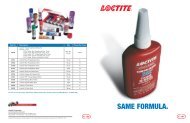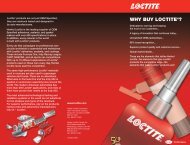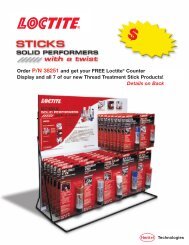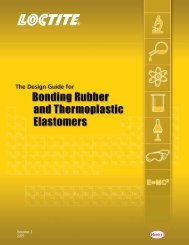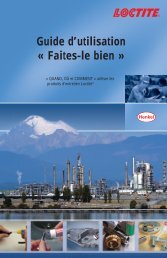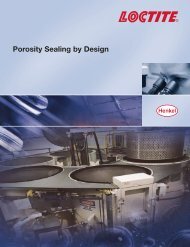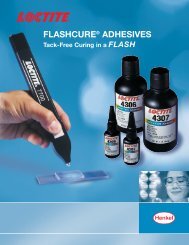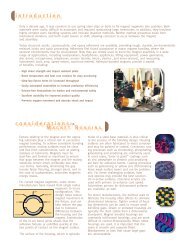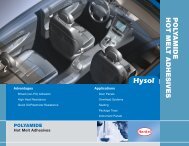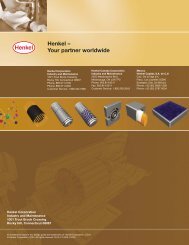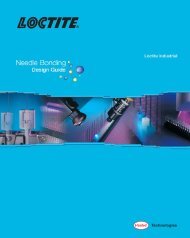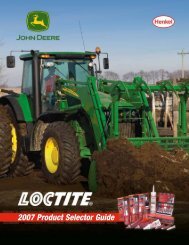Cellulose Acetate Propionate (CAP)ThermoplasticTrade Names• TeniteManufacturerEastman Chemical ProductsGeneral DescriptionCellulose is a naturally occurring polymer derived from wood pulp andcotton which is chemically modified to form a cellulosic plastic. The threemajor families of cellulose are ethyl cellulose, cellulose nitrate, andcellulose esters. The four most commonly used cellulose esters arecellulose acetate (CA), cellulose acetate butyrate (CAB), cellulose acetatepropionate (CAP), and cellulose triacetate. Cellulose acetate propionate,one of the most commonly used cellulosic polymers, is manufactured byreacting cellulose with propionic acid and propionic anhydride. Cellulosicsare tough, abrasion resistant plastics that have found use in a variety ofapplications such as films, dice, and eyeglasses. Specialty gradesavailable include plasticized, UV stabilized, flame retardant, and colored.In 2004, the price of CAP ranged approximately from $1.75 to $2.00 perpound at truckload quantities.Typical Properties of Cellulose Acetate Propionate (CAP)American EngineeringProcessing Temperature 446°F to 464°F 230°C to 240°CLinear Mold Shrinkage 0.002 to 0.006 in./in. 0.002 to 0.006 cm/cmMelting Point 300°F to 400°F 149°C to 204°CDensity 74.9 to 81.2 lb./ft. 3 1.20 to 1.30 g/cm 3Tensile Strength, Yield 3.6 to 6.1 lb./in. 2 x 10 3 2.5 to 4.3 kg/cm 2 x 10 2Tensile Strength, Break 4.5 to 7.1 lb./in. 2 x 10 3 3.2 to 5.0 kg/cm 2 x 10 2Elongation, Break 34.0 to 50.0% 34.0 to 50.0%Tensile Modulus – –Flexural Strength, Yield 4.4 to 8.2 lb./in. 2 x 10 3 3.1 to 5.8 kg/cm 2 x 10 2Flexural Modulus 1.9 to 3.2 lb./in. 2 x 10 5 1.3 to 2.2 kg/cm 2 x 10 4SIGeneral PropertiesThe main benefits offered by cellulosics are clarity, toughness at lowtemperatures, abrasion resistance, glossy appearance, resistance tostress cracking, and good electrical insulating properties. Other benefitsof cellulosics include a warm, pleasant feel to the touch (due to their lowthermal conductivity and specific heat), the availability of formulationswhich can be used in contact with food, and the ability to be processedby most thermoplastic methods. Generally, plasticizers are added tolower the melt temperature and modify the <strong>ph</strong>ysical properties. Asplasticizer is added, the hardness, stiffness and tensile strengthdecrease, while the impact strength increases. The solvent resistance ofcellulosics varies with type. In general, they are resistant to attack byali<strong>ph</strong>atic hydrocarbons, bleach, ethylene glycol, salt solutions, andvegetable and mineral oils. However, cellulosics are known to beattacked by alkaline materials and fungus. Cellulosics are further limitedby their flammability, low continuous use temperatures, and poorresistance to weathering, although UV resistant grades are available.Compressive Strength 4.4 to 8.1 lb./in. 2 x 10 3 3.1 to 5.8 kg/cm 2 x 10 2Izod Notched, R.T. 1.2 to 8.3 ft.-lb./in. 6.5 to 44.8 kg cm/cmHardness R75 - R130 Rockwell R75 - R130 RockwellThermal Conductivity 1.73 to 1.74 BTU-in./hr.-ft. 2 -°F 0.246 to 0.251 W/m-°KLinear ThermalExpansionDeflection Temperature@ 264 psiDeflection Temperature@ 66 psiContinuousService Temperature– –120°F to 200°F 49°C to 93°C140°F to 230°F 60°C to 110°C– –Dielectric Strength – –Dielectric Constant@ 1 MHzDissipation Factor@ 1 MHzWater Absorption,24 hr.3.5 to 3.6 3.5 to 3.60.020 to 0.030 0.020 to 0.0301.3 to 2.4% 1.3 to 2.4%Typical Applications• Films – Photogra<strong>ph</strong>ic film, audio tape, visual aids,greeting cards, <strong>ph</strong>oto albums• Miscellaneous – Lacquer and cement base, explosives, fashionaccessories, flashlight cases, fire extinguisher components, toys,tool handles, electrical appliance housings, eyeglass framesand lenses, lighting fixtures, brush handles24The <strong>Loctite</strong> ® Design Guide for Bonding Plastics, <strong>Volume</strong> 4
ADHESIVE SHEAR STRENGTH(psi)(MPa)Cellulose Acetate PropionateUNFILLED RESIN3 rmsROUGHENED19 rmsANTIOXIDANT0.15% Irganox 1010UV STABILIZER0.2% Chimasorb 994FLAME RETARDANT17% Reofos 35PLASTICIZER9% Benzoflex 988LUBRICANT0.1% Zinc StearateFILLER #117% 497 FiberglassFILLER #217% Omyacarb F CzCO3COLORANT1% GreenANTISTATIC1.5% Markstat AL-12<strong>Loctite</strong> ® 380 Black Max ® Instant Adhesive,Rubber Toughened4002.84002.84002.84002.82501.72501.72501.74002.86504.54002.8170011.7Tenite 3754000012 produced byEastman Performance Products<strong>Loctite</strong> ® 401 Prism ® Instant Adhesive,Surface InsensitiveMEDICAL: <strong>Loctite</strong> ® 4011 Prism ®Instant Adhesive, Surface Insensitive<strong>Loctite</strong> ® 401 Prism ®<strong>Loctite</strong> ® 770 Prism ® PrimerMEDICAL: <strong>Loctite</strong> ® 4011 Prism ® /<strong>Loctite</strong> ® 7701 Prism ® Primer<strong>Loctite</strong> ® 414 Super Bonder ®Instant Adhesive, General Purpose<strong>Loctite</strong> ® 330 Depend ® Adhesive,Two-Part No-Mix Acrylic195013.5215014.8155010.712008.3195013.5155010.7155010.79006.2195013.5215014.8155010.77004.8>2450 1350>16.9 9.3200013.8200013.85503.810006.99006.26504.510507.212008.311507.96504.5195013.5215014.87505.23502.4195013.5>1950 † 1950>13.5 † 13.5>2200 >2150 2150>15.2 >14.8 14.8155010.76504.5155010.712008.3155010.78505.9>2200 >15.2 180012.4>2450 >16.9 4002.8<strong>Loctite</strong> ® 3105 Light Cure Adhesive,MEDICAL: <strong>Loctite</strong> ® 3311 Light Cure Adhesive185012.8185012.8185012.8185012.813009.0150010.3185012.8>1900 † >1600 † 1850>13.1 † >11.0 † 12.8>2250 >15.5 Tenite 375E4000012 produced by Eastman Performance Products courtesy of Albis Plastics 2 rms<strong>Loctite</strong> ® 3340 Light Cure Adhesive,UV Cationic Epoxy<strong>Loctite</strong> ® 4305 Flashcure ® Light Cure AdhesiveFLUORESCENT: <strong>Loctite</strong> ® 4307 Flashcure ®Light Cure Adhesive<strong>Loctite</strong> ® H3000 Speedbonder Structural Adhesive, General Purpose<strong>Loctite</strong> ® H4500 Speedbonder Structural Adhesive, Metal Bonder<strong>Loctite</strong> ® 3030 Adhesive, Polyolefin Bonder<strong>Loctite</strong> ® E-00CL Hysol ® Epoxy Adhesive,Low Odor<strong>Loctite</strong> ® E-90FL Hysol ® Epoxy Adhesive,Flexible<strong>Loctite</strong> ® E-30CL Hysol ® Epoxy Adhesive,Glass BonderMEDICAL: <strong>Loctite</strong> ® M-31CL Hysol ®Epoxy Adhesive, Glass Bonder<strong>Loctite</strong> ® E-20HP Hysol ® Epoxy Adhesive,Fast SettingMEDICAL: <strong>Loctite</strong> ® M-21HP Hysol ®Epoxy Adhesive, Fast Setting<strong>Loctite</strong> ® E-214HP Hysol ® Epoxy Adhesive,High Strength<strong>Loctite</strong> ® Fixmaster ® High Performance Epoxy<strong>Loctite</strong> ® 1942 Hysol ® Hot Melt Adhesive,EVA Based<strong>Loctite</strong> ® 3651 Hysol ® Hot Melt Adhesive,Polyolefin<strong>Loctite</strong> ® 7804 Hysol ® Hot Melt Adhesive<strong>Loctite</strong> ® 3631 Hysol ® Hot Melt Adhesive,Urethane<strong>Loctite</strong> ® U-05FL Hysol ® Urethane Adhesive,High Strength<strong>Loctite</strong> ® Fixmaster ® Rapid Rubber RepairOEM: <strong>Loctite</strong> ® U-04FL Hysol ®Urethane Adhesive, Fast Setting<strong>Loctite</strong> ® 5900 ® Flange Sealant,Heavy Body RTV Silicone>1950 >13.4 190013.15503.86004.1>2000 >13.8 11007.64002.810507.2155010.7NOTTESTED>3050 >21.0 2501.7500.31501.0195013.510006.97004.82001.4Adhesive Performance<strong>Loctite</strong> ® 3340 Light Cure Adhesive, <strong>Loctite</strong> ® 3030 Adhesive and <strong>Loctite</strong> ® Fixmaster ® High PerformanceEpoxy all created bonds that were stronger than the standard grade of CAP tested. <strong>Loctite</strong> ® 401 Prism ®and 414 Super Bonder ® Instant Adhesives, <strong>Loctite</strong> ® 4305 Flashcure ® and 3105 Light Cure Adhesives,and <strong>Loctite</strong> ® 3631 Hysol ® Hot Melt Adhesive typically achieved the next highest bond strengths on CAP.<strong>Loctite</strong> ® 330 Depend ® Adhesive, <strong>Loctite</strong> ® E-00CL , E-30CL and and E-20HP Hysol ® Epoxy Adhesivesand <strong>Loctite</strong> ® U-05FL Hysol ® Urethane Adhesive performed exceptionally as well.Surface Treatments<strong>Loctite</strong> ® 770 Prism ® Primer, when used in conjunction with <strong>Loctite</strong> ® 401 Prism ® Instant Adhesive, or<strong>Loctite</strong> ® 4011 Prism ® Instant Adhesive with <strong>Loctite</strong> ® 7701 Prism ® Primer, had no overall statisticallysignificant effect on the formulations of CAP which were evaluated. However, it did cause a statisticallysignificant decrease in bond strengths achieved on the UV stabilized and antistatic formulations, and astatistically significant increase for the glass and calcium carbonate filled formulations. Surfaceroughening caused either no effect or a statistically significant decrease in the bondability of CAP.Other Important Information• Cellulosics can be stress cracked by uncured cyanoacrylate adhesives,so any excess adhesive should be removed from the surface immediately.• Cellulosics are compatible with acrylic adhesives, but can be attacked by their activators before theadhesive has cured. Any excess activator should be removed from the surface immediately.• Surface cleaners: isopropyl alcohol, <strong>Loctite</strong>® ODC-Free Cleaner & Degreaser.NOTES: The force applied to the tests specimens exceededthe strength of the material resulting in substrate failurebefore the actual bond strength achieved by theadhesive could be determined.† Due to the severe deformation of the block shearspecimens, testing was stopped before the actual bondstrength achieved by the adhesive could be determined(the adhesive bond never failed).NOT TESTED: Substrate melted at adhesivecure temperature.The addition of the indicated additive (or surfaceroughening) caused a statistically significant decrease inthe bond strength within 95% confidence limits.The addition of the indicated additive (or surfaceroughening) caused a statistically significant increasein the bond strength within 95% confidence limits.The <strong>Loctite</strong> ® Design Guide for Bonding Plastics, <strong>Volume</strong> 4 25



